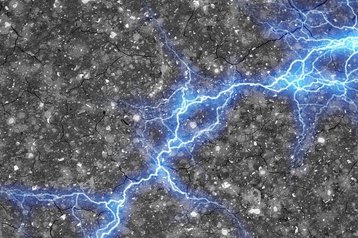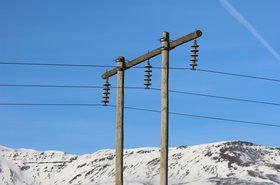Researchers at MIT have proposed a new battery alternative made from very basic materials.
Blocks of cement infused with a form of carbon similar to soot could store enough energy to power whole households. A single 3.5-meter block could hold 10kWh of energy, and power a house for a day, and the technology could be commercialized in a matter of years, the scientists say.
Similar capacitors built into roads could charge cars wirelessly, say MIT professors Franz-Josef Ulm, Admir Masic, and Yang-Shao Horn, and others at MIT and at the Wyss Institute for Biologically Inspired Engineering, in a paper.
The scientists found that carbon black, a form of the element found in incompletely burnt material, can be added to cement blocks as they set, turning them into supercapacitors, able to hold large electrical charges.
Capacitors hold electrical charge, on separated metal conductors. The energy they hold depends on the surface area of the conductive material, and the team discovered that they could create a massive surface area very simply, by adding carbon black to wet cement.
Carbon black is very conductive, and it diffuses in the wet cement, entering cavities left by the water as it reacts during the curing process. This creates a network of tiny wire-like microfibers within the eventual solid concrete block, structured in a fractal way, with multiple branches supporting ever smaller branches.
The material is then soaked in salt such as potassium chloride, which acts as an electrolyte, providing the charged particles that accumulate on the carbon structures. Two electrodes made of this material, separated by a thin space or an insulating layer, form a very powerful supercapacitor.
“The material is fascinating,” Masic says, “because you have the most-used manmade material in the world, cement, that is combined with carbon black, that is a well-known historical material — the Dead Sea Scrolls were written with it. You have these at least two-millennia-old materials that when you combine them in a specific manner you come up with a conductive nanocomposite, and that’s when things get really interesting.”
As the mixture sets, “the carbon black is self-assembling into a connected conductive wire,” he says.
Cement capacitors can be produced anywhere in the world, and the blocks work with as little as three percent of carbon black in the mixture.
The blocks could help with energy transition, because around the world energy storage is needed to balance renewable energy such as solar and wind power, which is not produced at the same time it is needed.
“There is a huge need for big energy storage,” says Ulm, and existing batteries are expensive and rely on materials such as lithium, whose supply is limited, so cheaper alternatives are badly needed. “That’s where our technology is extremely promising, because cement is ubiquitous."
The team worked out that a 45 cubic meter material block of nanocarbon-black-doped concrete would have enough capacity to store about 10kWh of energy, which is reckoned to be the average daily electricity usage for a household, so remote off-grid houses with batteries in the foundations could operate using windmills or solar panels.
In data centers, it might be possible to have UPS batteries which are part of the structure of the building.
If more powerful capacitors are required, they can be made with a larger concentration of carbon black, at the expense of some structural strength. This could be useful for applications where the concrete is not playing a structural role or where the full strength potential of concrete is not required. For applications such as a foundation, or structural elements of the base of a wind turbine, the “sweet spot” is around 10 percent carbon black in the mix, the team says.
As a proof of concept, the team started very small, with supercapacitors about the size of a button-cell battery, one centimeter across and one millimeter thick. Three of these were charged to one volt, and used to power a 3V light-emitting diode (LED).
The next step is to make blocks the size of a typical 12-volt car battery, then work up to a 45-cubic-meter version to demonstrate its ability to store a house-worth of power.
Beyond this, cement capacitors could be built into concrete roadways where they would store energy produced by solar panels beside the road, and deliver it wirelessly to charge vehicles traveling along the road. Wireless charging for cars is being used in Germany and other places.
Ulm says that the system is very scalable, as the energy-storage capacity is a direct function of the volume of the electrodes. “You can go from one-millimeter-thick electrodes to one-meter-thick electrodes, and by doing so basically you can scale the energy storage capacity from lighting an LED for a few seconds, to powering a whole house,” he says. It is also tunable allowing faster or slower charging, according to the mixture used.
Emissions from concrete in the construction industry are huge, making up eight percent of the world's emissions, more than that produced by the airline industry. Ulm says turning concrete into energy storage could make it “part of the energy transition.”
The research team also included postdocs Nicolas Chanut and Damian Stefaniuk at MIT’s Department of Civil and Environmental Engineering, James Weaver at the Wyss Institute, and Yunguang Zhu in MIT’s Department of Mechanical Engineering. The work was supported by the MIT Concrete Sustainability Hub, with sponsorship by the Concrete Advancement Foundation.







